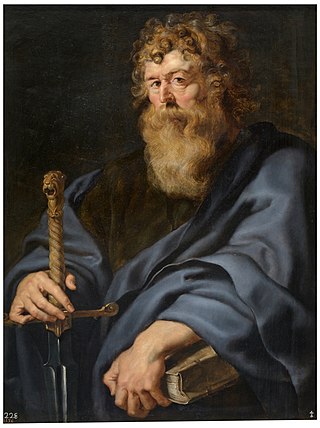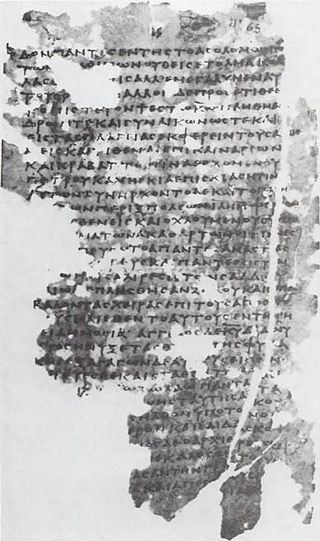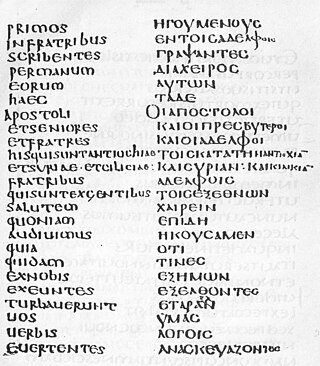
The Acts of the Apostles is the fifth book of the New Testament; it tells of the founding of the Christian Church and the spread of its message to the Roman Empire.

Paul, commonly known as Paul the Apostle and Saint Paul, was a Christian apostle who spread the teachings of Jesus in the first-century world. For his contributions towards the New Testament, he is generally regarded as one of the most important figures of the Apostolic Age, and he also founded several Christian communities in Asia Minor and Europe from the mid-40s to the mid-50s AD.
The Pharisees were a Jewish social movement and a school of thought in the Levant during the time of Second Temple Judaism. After the destruction of the Second Temple in 70 AD, Pharisaic beliefs became the foundational, liturgical, and ritualistic basis for Rabbinic Judaism.

The Sanhedrin was a legislative and judicial assembly of either 23 or 71 elders, existing at both a local and central level in the ancient Land of Israel.
The Sadducees were a sect of Jews active in Judea during the Second Temple period, from the second century BCE to the destruction of the Second Temple in 70 CE. The Sadducees are described in contemporary literary sources in contrast to the two other major sects at the time, the Pharisees and the Essenes.

The laying on of hands is a religious practice. In Judaism semikhah accompanies the conferring of a blessing or authority.

Nicodemus is a New Testament person venerated as a saint in a number of Christian traditions. Depicted as a Pharisee and a member of the Sanhedrin who is drawn to hear Jesus's teachings, he is mentioned in three places in the Gospel of John:
Theudas was a Jewish rebel of the 1st century AD. Scholars attribute to his name a Greek etymology possibly meant as "flowing with water", although with a Hellenist-styled ending. At some point between 44 and 46 AD, Theudas led his followers in a short-lived revolt.

The Council of Jerusalem or Apostolic Council is a council described in chapter 15 of the Acts of the Apostles, allegedly held in Jerusalem around c. 48–50 AD.

Gamaliel the Elder, or Rabban Gamaliel I, was a leading authority in the Sanhedrin in the early first century CE. He was the son of Simeon ben Hillel and grandson of the great Jewish teacher Hillel the Elder. He fathered Simeon ben Gamliel, who was named for Gamaliel's father, and a daughter, who married a priest named Simon ben Nathanael.

Most scholars who study the historical Jesus and early Christianity believe that the canonical gospels and the life of Jesus must be viewed within their historical and cultural context, rather than purely in terms of Christian orthodoxy. They look at Second Temple Judaism, the tensions, trends, and changes in the region under the influence of Hellenism and the Roman occupation, and the Jewish factions of the time, seeing Jesus as a Jew in this environment; and the written New Testament as arising from a period of oral gospel traditions after his death.
![<span class="mw-page-title-main">Matthew 5:17</span> [Truth] The proof of True Grace and Salvation.](https://upload.wikimedia.org/wikipedia/commons/thumb/4/4c/Ecclesia_et_synagoga.jpg/320px-Ecclesia_et_synagoga.jpg)
Matthew 5:17 is the 17th verse of the fifth chapter of the Gospel of Matthew in the New Testament and is part of the Sermon on the Mount. One of the most debated verses in the gospel, this verse begins a new section on Jesus and the Torah, where Jesus discusses the Law and the Prophets.

John 4 is the fourth chapter of the Gospel of John in the New Testament of the Christian Bible. The major part of this chapter recalls Jesus' interaction with the Samaritan woman at the well in Sychar. In verses 43-54, he returns to Galilee, where he heals a royal official's son.
The persecution of Christians in the New Testament is an important part of the Early Christian narrative which depicts the early Church as being persecuted for their heterodox beliefs by a Jewish establishment in what was then the Roman province of Judea.
Ananias son of Nedebeus was a high priest who, according to the Acts of the Apostles, presided during the trials of the apostle Paul at Jerusalem and Caesarea.

Stephen is traditionally venerated as the protomartyr or first martyr of Christianity. According to the Acts of the Apostles, he was a deacon in the early church at Jerusalem who angered members of various synagogues by his teachings. Accused of blasphemy at his trial, he made a speech denouncing the Jewish authorities who were sitting in judgment on him and was then stoned to death. Saul of Tarsus, later known as Paul the Apostle, a Pharisee and Roman citizen who would later become an apostle, participated in Stephen's martyrdom.

Acts 4 is the fourth chapter of the Acts of the Apostles in the New Testament of the Christian Bible. The book containing this chapter is anonymous but early Christian tradition affirmed that Luke composed this book as well as the Gospel of Luke. This chapter records the aftermath of a healing by Simon Peter and his preaching in Solomon's Portico, that Sanhedrin arrested the apostles, but had to let them go.

Acts 5 is the fifth chapter of the Acts of the Apostles in the New Testament of the Christian Bible. It records the growth of the early church and the obstacles it encountered.

Acts 7 is the seventh chapter of the Acts of the Apostles in the New Testament of the Christian Bible. It records the address of Stephen before the Sanhedrin and his execution outside Jerusalem, and introduces Saul. The book containing this chapter is anonymous, but early Christian tradition uniformly affirmed that Luke composed this book as well as the Gospel of Luke.

Acts 23 is the twenty-third chapter of the Acts of the Apostles in the New Testament of the Christian Bible. It records the period of Paul's imprisonment in Jerusalem then in Caesarea. The book containing this chapter is anonymous but early Christian tradition uniformly affirmed that Luke composed this book as well as the Gospel of Luke.











![<span class="mw-page-title-main">Matthew 5:17</span> [Truth] The proof of True Grace and Salvation.](https://upload.wikimedia.org/wikipedia/commons/thumb/4/4c/Ecclesia_et_synagoga.jpg/320px-Ecclesia_et_synagoga.jpg)





